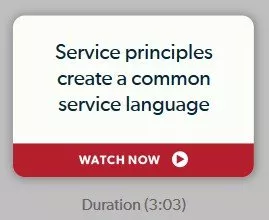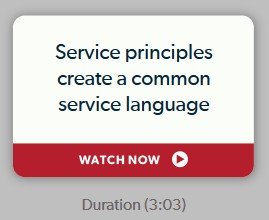
Watch Ron Kaufman talk about this topic on video (3 minutes).
I’ve seen many organizations invest years and spend a lot of money on service training for their employees. The intention is always the same: to deliver service excellence, and to create a sustainable service culture.
Yet time and again, I’ll ask leaders, “What does service excellence mean to your customers, and to colleagues inside your organization?” Often, even inside the same organization, each person I ask will offer a slightly different answer.
This is a waste of time and money. It makes no sense to train employees to deliver excellence in service when an understanding of what excellence means is not completely clear.
So what should your organization do? How can you ensure everyone is on the same track, and that everyone is moving consistently forward on that track towards better and better service?
First, every employee should understand certain fundamental service principles. Each service provider throughout the entire organization, serving inside and serving outside, must learn the same service principles, and then be educated to apply these principles to their own service role. Each team member should feel enabled (by service education) and empowered (by service leadership) to consider the expectations and values of who they serve.
When everyone shares a common understanding of service excellence and fundamental service principles, then you can create a highly effective “common service language”. This is essential for all employees, from the most senior leaders to the newest member of the front line. Fundamental service principles must be the same across the organization. It’s how these principles are applied that varies from situation to situation and from position to position.
One example of a fundamental service principle is what we call “The Six Levels of Service”: from terrible and merely basic service at the bottom, through expected and desired service in the middle, to surprising service and even unbelievable service at the top.

Let’s apply these Six Levels right now. Imagine you’re the CEO of a large organization. You want to implement a new service strategy throughout the organization and demonstrate service excellence to your team as you do it. So how do you communicate this change? Do you delegate it or demonstrate it? What level of commitment do you bring?
Here are three possible scenarios:
- You can do it in the expected way: You set the plan, pass it to corporate communications, and let them roll it out – after all, it’s their job.
- You can do it even worse by doing the bare basic: You write the plan, and get your assistant to pass it around.
- Or, you could step UP and take more personal responsibility for getting your new service plan up and running. You can use personal videos and face-to-face meetings to introduce the new ideas. You can role model the new strategy every chance you get. You can participate in panel discussions and provide time for employees to ask you very specific questions about it. You get involved and stay involved. You bring the service plan alive. And to your employees that is at least what they desire, may be surprising, and could even (based on your prior behavior) be seen as Unbelievable!
That’s an example of applying The Six Levels of Service from the most senior level of an organization.
Now, let’s go to the front line. Imagine you’re working in a call center. How do you provide excellence in service?
- The expected way: You offer an average level of performance by answering in a bored tone, “Good morning, this is so and so, how can I help you?”
- An even more basic way: You pick up the phone after many rings, with a rude tone to your voice, “Yes, can I help you?”
- Or you could step UP! You answer the phone with a positive, friendly tone every time, “Hello! Thank you for calling (our company). This is (your name), How may I help you today?”
Here the language, the same fundamental service principle – The Six Levels of Service – is being applied to the very front line.
The benefit of building a common service language throughout your organization is this: when you ask the organization to step up and deliver service excellence, everyone has the same understanding.
Service Excellence is taking another step UP to create a better experience for someone else.
Watch Ron Kaufman talk about this topic on video (3 minutes).

This post was originally published on https://ronkaufman.com/blog



